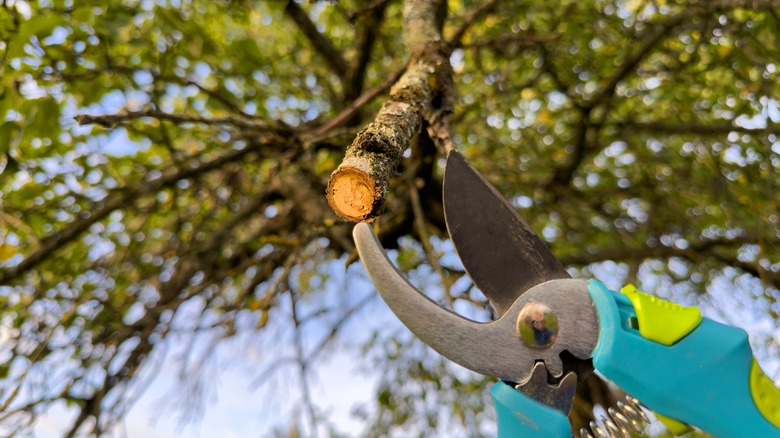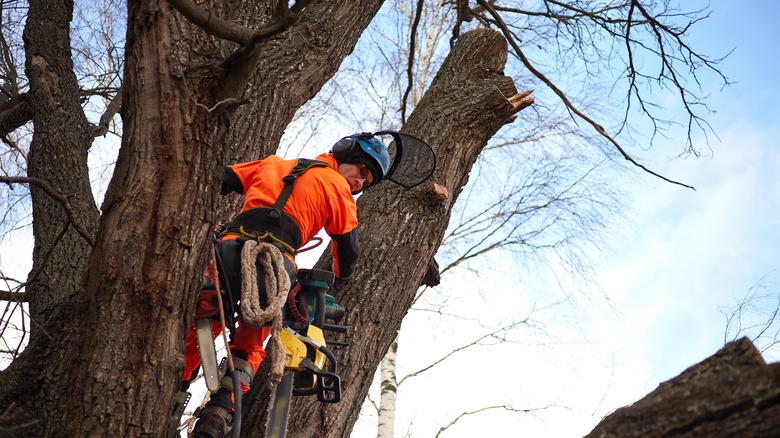The Best Time Of Year To Prune Your Oak Trees
Oak trees are a beautiful addition to any front or backyard. Not only do they make a statement with their sweeping height — a burr oak can grow up to 80 feet tall – but they also provide plenty of summer shade for your family and tons of shelter for neighborhood animals, such as birds and squirrels. While they don't need weekly care as your flower beds or vegetable patches might, they still need some tending. Specifically, you need to prune your oak tree from time to time, but you shouldn't pick up your sheers whenever the thought strikes. Instead, you need to wait until it's the best time to trim your oak tree — during late winter or the very beginning of spring. The reason for this is you want the tree to be dormant for the pruning process.
There are several reasons why you might need to prune your oak. Perhaps a few wayward branches are growing too close to your house or an important structure. Maybe you have a few injured branches from a previous storm that need cutting, or possibly you have spotted a couple of diseased limbs that will need to be removed. Whatever the reason, your best bet is to make these cuts during winter and the very beginning of spring.
Why you should prune oak trees in winter and early spring
There are several reasons to wait until winter and early spring to bring out your cutting sheers. First, it's more convenient. The plant won't have any leaves, allowing you to easily see where you need to cut. This ensures you don't cut more than you need to, resulting in a less injured tree. Second, pruning trees during the winter ensures that there won't be any new growth since the plant is dormant. In contrast, if you bring out the sheers in fall, the tree will direct its resources to grow a new bud in its place. This will deplete some of the energy that it needs to survive the winter, and the new bud will be too small and weak to pull through the cold season, thus dying and damaging the tree. By pruning it during the winter or late spring, you won't risk that.
Lastly, and most importantly for oak trees in particular, pruning during the dormant season reduces the chance of oak wilt. This is a potentially fatal infection for oak trees, and it's caused when open wounds seeping with sap attract infected pests, transferring the disease to the tree. These bugs are at the highest risk during the growing season — aka, April and October — so performing any cuts before and after that time block minimizes the risk of contracting the disease.
Caveats to keep in mind
There are some caveats to keep in mind when pruning your oak tree. First, you want to trim as little as possible per season to minimize stress and avoid removing too many of its leaves. Doing so will reduce its ability to photosynthesize and protect itself from the hot sun during summer. As a rule, you shouldn't remove more than 5% of its canopy if you're doing some annual upkeep and cleaning. If it's been sometime between pruning and you need more robust maintenance, you shouldn't remove more than 15% of an oak tree's limbs at a time. If you need to trim more, create a pruning plan that is staggard across a few years.
If you have an oak that received a wound during the summer, you might think you have no choice but to prune it then and there. But to protect it from the threat of oak wilt, cover the injuries with either latex-based paint or special tree-wound paint such as Tanglefoot Tree Wound Pruning Sealer & Grafting Compound, which is $10 at Menards. Hopefully, this will keep it safe and protected until you can remove the branch in the winter. Lastly, you should consider leaving the tree pruning to professional arborists if your oak is taller than 15 feet. They are more knowledgeable about where it's safe to cut, and they will also have the proper safety equipment to scale such tall heights and remove large and heavy limbs.


